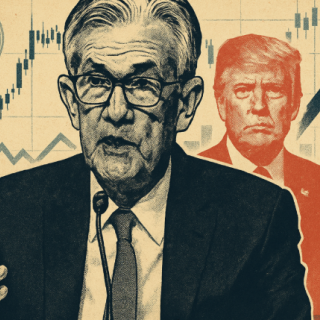


Federal Reserve Chair Jerome Powell on Tuesday delivers his last scheduled remarks before the Fed's next meeting with the economy enjoying stronger-than-expected growth and a recent jump in productivity, but still adjusting to tariff and immigration policies that economists worry could lead to both higher inflation and higher unemployment.
Challenging for a central bank responsible for keeping inflation low and employment as high as possible, Powell and his colleagues are also facing a drought of official data amid a U.S. government shutdown that has delayed the September jobs report and other key statistics. An update on consumer prices is now scheduled for October 24, before the Fed's October 28-29 meeting.
Investors expect the Fed to lower its benchmark interest rate by a quarter-of-a-percentage point to the 3.75%-to-4.00% range, and then lower it again in December.
But the competing forces in the economy right now have become tangled, said EY-Parthenon Chief Economist Gregory Daco.
"There are conflicting forces that are affecting the US economy, in particular, with the US economy essentially being constrained by tariffs...Also by reduced immigration," Daco said at a meeting of the National Association for Business Economics conference, where Powell speaks on Tuesday. "At the same time, we're seeing a great deal of investment on the AI front These forces are offsetting one another, not necessarily proportionally, not necessarily at the same time, but I think it's a very interesting duel."
How fast the tension resolves into a more consistent view of the economy will be crucial for coming Fed decisions.
Policymakers are divided between those concerned that inflation remains above the Fed's 2% target and is expected to remain so through next year, and those who see the job market at risk of a fast slide.
"Something's got to give," Fed Governor Christopher Waller told CNBC last week. He noted the contradiction between economic growth estimates getting revised higher - nearing 4% for the third quarter, according to the Atlanta Fed's GDPNow model - and a job market that seems in the doldrums with a recent report from payroll processor ADP showing the economy lost jobs in September.
"You can't have negative job growth and 4% GDP growth....Either the labor market rebounds to match the GDP growth, or GDP growth is going to pull back," said Waller, who favors further rate cuts to protect the job market, but says those should come in cautious, quarter-point moves to avoid a mistake.
The Fed's quarter-point reduction in September was framed as a way to balance potential strains on the job market while still leaving rates high enough to maintain downward pressure on inflation.
In the absence of the September jobs report, officials like Waller have noted that an array of private-sector indicators have pointed to weak hiring, even if none on their own is a perfect substitute for the Bureau of Labor Statistics' monthly surveys of businesses and households.
Source: Investing.com
Conflicting signals from the Federal Reserve on the timing and magnitude of U.S. interest rate cuts have accelerated hedging flows into swaptions and derivatives tied to overnight rates, with investor...
Markets are pricing in a near-certain 25bp Fed cut in December, influenced by dovish Fed chatter and signs of a slowing US economy, while the US Dollar (USD) shows mixed reactions. Kevin Hassett seen...
U.S. Treasury Secretary Scott Bessent said on Tuesday he was concluding a second round of interviews later in the day for a new U.S. Federal Reserve leader, and there was a good chance President Donal...
Allies of Federal Reserve Chair Jerome Powell have laid the groundwork for him to push through an interest rate cut during the central bank's December 9-10 meeting, the Wall Street Journal's Nick Timi...
Chicago Federal Reserve President Austan Goolsbee on Thursday said he is uneasy about cutting interest rates in the face of too-high inflation that's steady at best and by some measures getting worse,...
Crude oil futures fell slightly on Friday (November 28th) as investors weighed the geopolitical risk premium on oil amid protracted Russia-Ukraine peace talks, while keeping an eye on Sunday's OPEC+ meeting for clues on potential production...
Gold surged past $4,220 an ounce on Friday (November 28th) to a one-month high and is on track for a fourth straight monthly gain as markets price in a higher probability of a Fed rate cut in December. Dovish statements from several Fed officials...
European stocks ended Friday in positive territory as investors digested the end of a choppy month. The pan-European Stoxx 600 closed the session 0.2% higher, with major bourses and most sectors in positive territory. November has been a volatile...
 Trading on the Chicago Mercantile Exchange (CME) was halted on Friday (November 28th) following a cooling issue at one of its data centers.
"Due to...
Trading on the Chicago Mercantile Exchange (CME) was halted on Friday (November 28th) following a cooling issue at one of its data centers.
"Due to...
 Conflicting signals from the Federal Reserve on the timing and magnitude of U.S. interest rate cuts have accelerated hedging flows into swaptions...
Conflicting signals from the Federal Reserve on the timing and magnitude of U.S. interest rate cuts have accelerated hedging flows into swaptions...
 Both the STOXX 50 and the STOXX 600 hovered around the flatline on the final trading day of a volatile November, as the recent rally in global...
Both the STOXX 50 and the STOXX 600 hovered around the flatline on the final trading day of a volatile November, as the recent rally in global...
 European stocks ended Friday in positive territory as investors digested the end of a choppy month.
The pan-European Stoxx 600 closed the session...
European stocks ended Friday in positive territory as investors digested the end of a choppy month.
The pan-European Stoxx 600 closed the session...